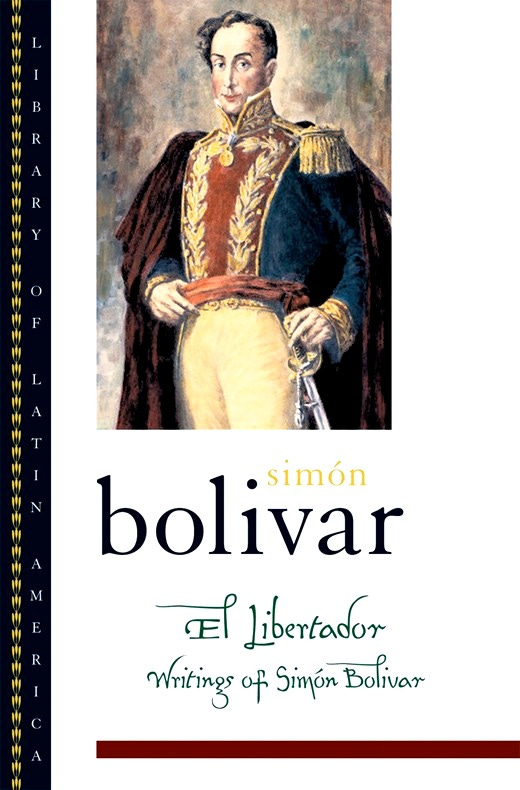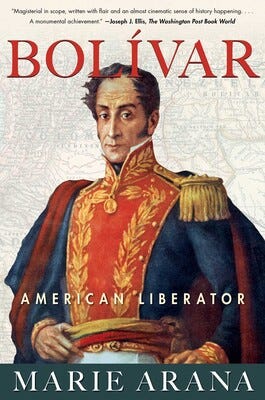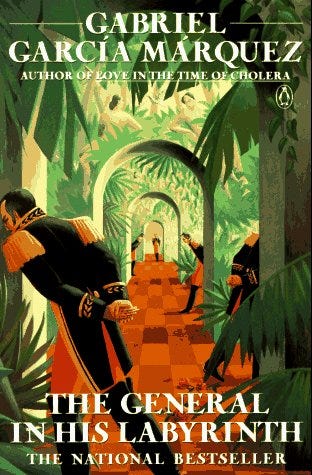Happy New Year! I hope you find lots of love, warmth, and happiness in 2025.
This is the year I finish a draft of my book, “A Thousand Bridges,” a history of Latinos since the Spanish conquest. I’m telling you this more to hold myself accountable than to keep you apprised—though I do want to keep you apprised. I’ve said it, so now I have to do it!
For the past month, I’ve been working on a chapter about Simón Bolívar, the “Liberator” who in many ways authored South America’s independence from Spain. I’m sure you’ve heard of him. : )
So much has been written about him. What could I possibly write that hasn’t been written before? Well, the best I can do is focus on his significance in the context of Latino history.
And in this sense, I think his two main contributions are: 1) his imagination of South American unity, which never was realized (and which in many ways anticipated Latinos’ elusive quest for unity); and 2) his involvement in the formation of Latin American nations. Half of Latinos today identify primarily with their national identities, as Colombian, or Venezuelan, or Peruvian, or Bolivian, or Panamanian. These nations didn’t exist before Bolívar.
There’s also his thinking about América’s cultural and racial identity, but I don’t think his insights here are unique to him. Many Latin American writers before and after Bolívar wrote about the mixed race character of Spanish Americans, a mix of Indigenous and African as much as of Indigenous and European.
This may seem obvious, but it’s not exactly how other histories of Latinos have treated him. They’ve focused primarily on Bolivar the anti-imperialist Liberator, who influenced later intellectuals and political leaders like José Martí, Fidel Castro, Hugo Chávez, all of which spoke and wrote about Bolívar at great length, and in many ways claimed him as the intellectual inspiration for their own movements.
But part of what drew me to Bolívar in the first place is how Latinos and Latin Americans with diverse views claim him; not just leftists like Castro and Chávez, but also rightwing Cuban Americans and Venezuelan Americans living in Miami. Those on the left and the right gather in front of the Bolívar statue in Bayfront park to celebrate all sorts of anniversaries, mainly of Latin American independence.
If you’re interested in incorporating Bolívar into your Latino history classrooms, I’d first recommend collections of his writings. I like Simón Bolivar: El Libertador, edited by David Bushnell and published by Oxford University Press:
But I’d recommend two others as well.
There’s Marie Arana’s masterful biography, Simón Bolivar: The Liberator, published by Simon & Schuster. (She recently published another good book called Latinoland). On the subject of unity (and the failure to realize it), see Arana’s accounts of his “Letter from Jamaica,” the first Pan-American Conference in Panama in 1826, and the Ocaña Conference in 1828. Also, I spoke with Arana about her book earlier this week, and learned she’s an alum of Northwestern, where I teach. Go ‘Cats!
Then there’s Gabriel García Márquez’s 1989 novel, The General In His Labyrinth. It’s about Bolivar’s final months, as he sailed up the Río Magdalena towards the Caribbean, from where he planned to depart for Europe. He died of tuberculosis before he made it—in December 1830, at the age of 47—and he spent much of his time on the trip grappling with his failure to unite South America.
So, dear readers, what are YOUR favorite Bolivar stories? What have you read by and about him that I need to read? I want to know!
Before I say bye for now, I want to share some of the pieces I wrote this past fall for The New Yorker, which kept me busy before and after the election:
“Understanding Latino Support for Donald Trump” (my post-election analysis)
“The Political Journey of a Top Latino Strategist for Donald Trump” (an essay about Carlos Trujillo, former Ambassador to the Organization of American States, and one of Trump’s main Latino surrogates)
“A Bronx ‘Family Album’ from Hip-Hop’s Early Days” (about Ricky Flores’s stunning photographs from the early eighties)
“The Challenge of Mapping the Latino Right” (my review of Paola Ramos’s book, The Defectors)
I also enjoyed these conversations, with Tyler Foggatt (about Tony Hincliffe’s Puerto Rico joke at MSG), and with David Remnick (about my reporting at the Republican National Convention):
I’m going to write more here in 2025, since I’m going to be deep deep deep into my book. And like I said at the beginning, I need the accountability, and, yes, I want you to know about what I’m finding!







Happy New Year Dr. Cadava. I took your class a few semesters back through Gilder-Lehrman and I would rank it as the most eye opening and fascinating classes of my entire program. Thank you for that. This idea of Simon Bolivar's legacy as a centripetal force among Latino populations is incredibly interesting. I show my own students an image of Nicolás Maduro giving a televeised address with two HUGE paintings of Bolivar behind him as we discuss the lasting legacy of Bolivár ( and de San Martin) on Latino identity. Students discuss why Maduro might think it important to associate himself with Bolivar and how he might see himself aligned with Bolivar's message of nationalism and independence. Thank you for these incredible recommendations to help deepen my understanding of Bolivar!
Tangentially related: I am on the hunt for work surrounding the Spanish Diaspora in America in the 20th century, particularly surrounding the events of the Spanish Civil War. This is the history of my own family and I am trying to gather some historical context to the quickly fading story of their immigration to the US in the 19teens from Galicia. I have found very few texts that focus on this subject. Thank you for your help! I look forward to reading your book when it is complete!